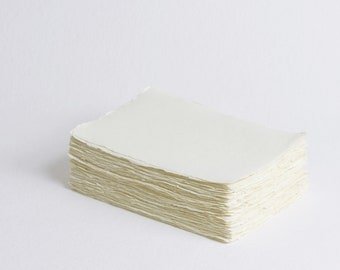Eco-Friendly Paper Alternatives
Eco-Friendly Paper Alternatives that are better for the Planet
Today I’m sharing five sustainable paper stock options for you to consider when printing business cards, marketing materials, etc. Before diving into my recommendations, please remember to use what you already have at home, even if it’s your normal white office paper from Staples or Amazon.
First up, and my personal favorite, is seed paper! I printed my last batch of business cards on seed paper and I love seeing people’s reaction when I tell them that they can plant my card and it will grow into wildflowers!
Seed paper looks and feels organic, and it is often made from cotton textiles which is mixed with seeds. When the paper is planted after it's been printed and used, the seeds will grow. However, the amount of ink used as well as the printing methods used can affect the success of your seed paper sprouting into a plant or flower.
Image Source: Oblation Papers
Stone paper is waterproof and it is often repurposed from construction waste. It has a very low carbon footprint that's 60% smaller than traditional papers because of the minimal amount of water that takes to produce. Although stone paper uses plastic in its production, it does alleviate pressure from cutting down ancient forests. Stone paper can also be recycled indefinitely.
Image Source: White Dragon Paper
Bamboo can be sustainably harvested for making paper and fabrics and it has the ability to grow almost anywhere. Though natural bamboo forests should not be turned into plantations for industrial use, bamboo plantations often exist on previously cleared or degraded land. The process of turning bamboo into paper is chemically intensive similar to traditional papers.
Image Source: Indian Cotton Paper Co.
Cotton paper is comprised of strong fibers that require less chemicals to produce. No other paper types yields paper with such a luxurious feel and unique texture, which is why a component of most currencies use cotton and linen fibers. However, reusing cotton textiles and reclaiming them into paper is a great way to recycle and reuse waste materials.
Image Source: Torn Edge Paper
Hemp is three times stronger than cotton, and it grows to maturity in approximately 90 days. It can be grown without pesticides, and has extremely low water use. It's a very resourceful and regenerative crop. Hemp paper requires extremely low water, chemical and energy requirements to produce high quality paper.
Image Source: Mohawk Paper
Straw paper requires little to no bleaching and carries a beautiful cream or golden tone. The production of straw paper requires 25% less water and 70% less energy than traditional paper. If straw pulp creation and capacity existed, and 25% of the agricultural waste product of straw was pulped, it could actually supply all of North America's book and copy paper demand single handedly. Mohawk makes a very nice straw paper (30% straw fibers) that come in two colors. I had a client recently order these for their mailers and am waiting for a sample. I’ll be sure to share a picture with you when it arrives.
Have you used or printed on any of these materials before? I would love to hear about your experience and any other favorite vendors you have, if so.






